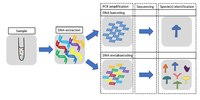
Photo from wikipedia
Marine infrastructure can favor the spread of non-indigenous marine biofouling species by providing a suitable habitat for them to proliferate. Cryptic organisms or those in early life stages can be… Click to show full abstract
Marine infrastructure can favor the spread of non-indigenous marine biofouling species by providing a suitable habitat for them to proliferate. Cryptic organisms or those in early life stages can be difficult to distinguish by conventional morphological taxonomy. Molecular tools, such as metabarcoding, may improve their detection. In this study, the ability of morpho-taxonomy and metabarcoding (18S rRNA and COI) using three reference databases (PR2, BOLD and NCBI) to characterize biodiversity and detect non-indigenous species (NIS) in biofouling was compared on 60 passive samplers deployed over summer and winter in a New Zealand marina. Highest resolution of metazoan taxa was identified using 18S rRNA assigned to PR2. There were higher assignment rates to NCBI reference sequences, but poorer taxonomic identification. Using all methods, 48 potential NIS were identified. Metabarcoding detected the largest proportion of those NIS: 77% via 18S rRNA/PR2 and NCBI and 35% via COI/BOLD and NCBI. Morpho-taxonomy detected an additional 14% of all identified NIS comprising mainly of bryozoan taxa. The data highlight several on-going challenges, including: differential marker resolution, primer biases, incomplete sequence reference databases, and variations in bioinformatic pipelines. Combining morpho-taxonomy and molecular analysis methods will likely enhance the detection of NIS from complex biofouling.
Journal Title: Scientific Reports
Year Published: 2018
Link to full text (if available)
Share on Social Media: Sign Up to like & get
recommendations!